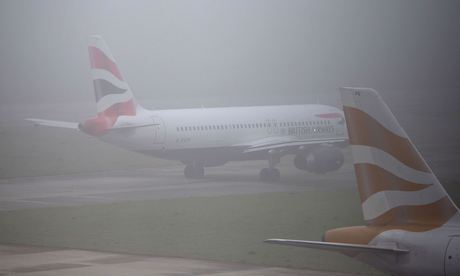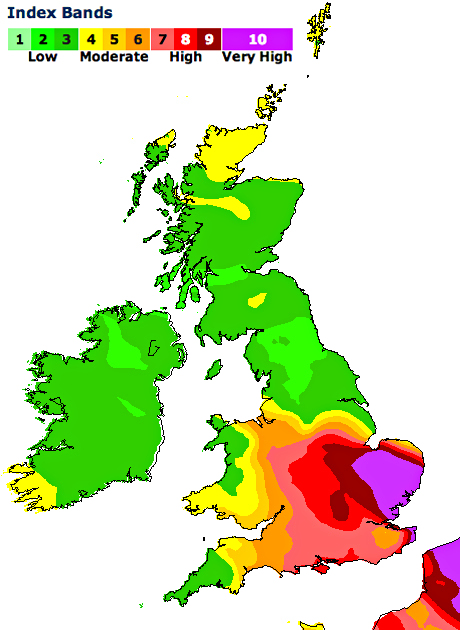
Millions of vulnerable people in southern England and Wales were advised to stay indoors as unusually high levels of air pollution smothered London and other cities, just weeks after heavy pollution led to restricted car use and free public transport in Brussels and Paris.
"That most important advice is for those people who are vulnerable, if you're in a high-pollution area, to reduce the amount of strenuous exercise outdoors over the next few days," Dr Paul Cosford, of Public Health England, told the BBC Radio 4 Today programme.
"Carry on life as normal - be aware you may need to use your inhalers more frequently - but carry on your life as normal. We do have problems with air pollution in our cities. The main sources we have are vehicle transport and the industrial process, when you put that alongside the unusual weather consequences like the Saharan dust ... then that's when you get these few days of unusually high pollution."
"Periods of very high pollution in London arise usually because the city's normal pollution emissions are increased further by polluted air arriving on light winds from neighbouring areas such as northern Europe," he said.
"However, whether home-produced or arriving from the continent, the tiny particles we take into our bodies with each breath cause immediate problems for some individuals such as those with asthma and contribute to longer-term problems for most of us in the form of heart disease and stroke.
Forecasters warned that one of the year's worst smogs would worsen as Wednesday progressed, with air pollution reaching the maximum "very high" level in many parts of southern Britain.
The unusually high levels of air pollution are a result of inland smog and powerful dust storms swept in from the Sahara by strong gales.
"We usually see this happen several times a year when big dust storms in the Sahara coincide with southerly winds to bring that dust here," said Paul Hutcheon at the Met Office. "More dust rain is possible during showers expected later this week."
The Department for Environment, Food and Rural Affairs (Defra) said air pollution levels on Wednesday were expected to reach eight or nine on a 10-point scale in much of southern England, the Midlands and southern Wales.
The southern coast - which was battered by torrential rain and storm winds earlier this year - is forecast to see pollution hit the maximum level 10.
Adults and children with lung problems, heart defects and older people are being urged to avoid any strenuous activity and asthma-sufferers have been told to use their inhaler more often.
Advice on the Defra website for the general population facing "very high" pollution levels states: "Reduce physical exertion, particularly outdoors, especially if you experience symptoms such as cough or sore throat."
Defra forecasters issued the fresh warning after air pollution levels reached 10 in north-west Norfolk on Tuesday.
"For England and Wales, moderate to high air pollution levels are forecast for central and south-east England, to the south and east of a line from around the Wash to Cheshire to east Devon, with local very high levels expected in parts of East Anglia and the East Midlands," said a Defra forecaster.
"This is due to light easterly winds continuing to bring in pollutants and allow local pollutants to remain close to source. There may also be some component due to Saharan dust."
Conditions are expected to worsen on Wednesday evening and into Thursday as the smog extends north.
High levels of pollution are forecast to stretch across East Anglia, the Midlands, Lincolnshire, through the Wirral to north and east Wales, then further norther over much of England's north-west coast, south-west Scotland and the north-east of Northern Ireland.
Cleaner air from the Atlantic should bring some respite for south-west wales and England's southern-most counties on Thursday, forecasters said, although many other parts of England and Wales will experience higher levels of smog than usual.
Keith Taylor, the Green party's member of European parliament for south-east England, said the high level of pollution showed the need for stronger government action.
"Episodes like this often have a number of contributing factors," he said. "What seems clear is that towns and cities across south-east England need to reduce the level of air pollution in their streets by cutting the amount of traffic. But on top of that it's clear that our government must play a role in pushing for stronger air pollution laws from the European Union, rather than trying to water down the rules we already have."
The UK faces fines of up to £300m a year and embarrassing court appearances after the European commission launched legal proceedings against it for failing to reduce "excessive" levels of nitrogen dioxide (NO2) air pollution from traffic, despite 15 years of warnings and several extensions and postponements granted to the government.
According to the World Health Organisation, air pollution has become the world's single biggest environmental health risk, linked to around 7 million deaths a year - or nearly one in eight deaths in 2012.




Reader Comments
to our Newsletter